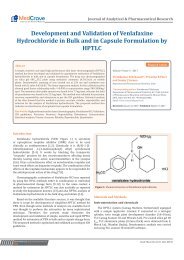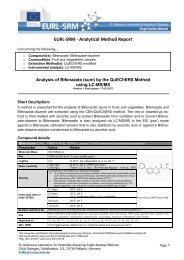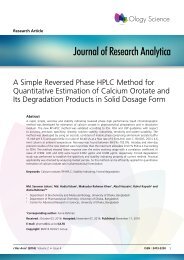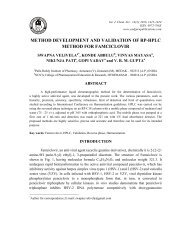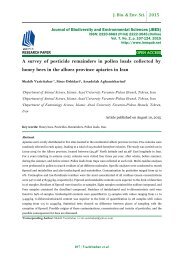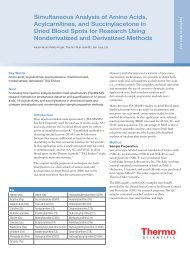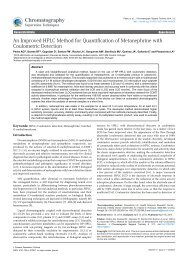acta 2_2015
acta 2_2015
acta 2_2015
- No tags were found...
Create successful ePaper yourself
Turn your PDF publications into a flip-book with our unique Google optimized e-Paper software.
344 NASER VAHED DEHKORDI et al.Antibacterial testThe antibacterial activity of the ethanol extractof E. procera was tested against the five pathogenicbacteria, including Proteus vulgaris, Pseudomonasaeruginosa, Enterobacter aerogenes, Bacillus cereusand Staphylococcus aureus by using the serial dilutionmethod. The extract demonstrated relativeinhibitory activities against the pathogenic bacteriatested. The growth inhibiting activity varied accordingto the dose and bacterial strain. The MICs andMBCs of the tested samples are presented in Table2. MBC values were mostly higher than MIC values.The results indicated that the different bacteriaspecies demonstrated different levels of sensitivityto the extract. The MICs of the extract were withinconcentration ranges from 250 to 500 µg/mL, andthe respective MBCs were 500 and > 500 µg/mL.Generally, the ethanol extract from E. procera indicatedmoderate to good inhibitory activities againstfive bacteria investigated. Antimicrobial activity ofsome Ephedra species, including Ephedra altissimaDesf. (35), Ephedra transitorai (36), Ephedra nebrodensis(37), and Ephedra breana (38) has beennoticed in recent years. Kwon et al. (39) reported theantimicrobial activity of Ephedra sinica extractsagainst bacteria, such as Vibrio parahaemolyticus,Clostridium perfringens, Bacillus subtilis andStaphylococcus aureus. In addition, Rustaiyan et al.(23) studied the antimicrobial capacity of themethanolic extract of E. sarcocarpa growing in Iranagainst Gram-positive and Gram-negative bacteriaand fungi. Results of their study indicated that theextract of E. sarcocarpa inhibited the growth ofGram negative bacteria, being Pseudomonas aeruginosa(MIC = 16 µg/mL). Results of other study byRustaiyan et al. (29) indicated the antimicrobialactivity of the methanolic extract of E. laristanicagrowing in Iran. They reported that the extract of E.laristanica inhibited the growth of Gram negativebacteria, especially Escherichia coli (MIC = 32µg/mL). Lee and Lee (10) reported that quinaldicacid isolated from the stems of E. pachyclada hadantibacterial activity against Clostridium difficileand C. perfringens, while had no effect on thegrowth of Bifidobacterium bifidum, Lactobacillusacidophilus and L. casei.Results from this study suggest that phenoliccompounds are responsible of the antibacterialactivity of extract of E. procera. Numerous workshave reported the antibacterial effects of thesemetabolites against a wide range of bacteria (40-42).Phenolic compounds can act at two different levels:the cell membrane and cell wall of the microorganisms(43). They can interact with the membrane proteinsof bacteria by means of hydrogen bondingthrough their hydroxyl groups, which can result inchanges in membrane permeability and cause celldestruction. They can also penetrate into bacterialcells and coagulate cell content (44).CONCLUSIONSThe present study is apparently the first report ofquantitative total phenol profile, antioxidant and antibacterialactivities of the ethanol extract from the aerialparts of E. procera. Results of this study indicatedthat the extract from E. procera had the highest antibacterialproperties. Phenolic compounds present in theplant are responsible for its effective free radical scavenging,antioxidant and antibacterial activities. Withregard to the results of this present study the extract ofE. procera could be an important source of phenoliccompounds with antioxidant capacity and antibacterialactivity. Nonetheless, in order to gain better views onthe antioxidant levels and activities in Ephedra species,further studies on purification, identification and quantificationof each phenolic compound and other nonphenoliccompounds are necessary in the future.AcknowledgmentsThis study was supported by Research Centerfor Medicinal Plants & Ethnoveterinary, I.A.U.,Shahrekord Branch, Iran.Table 2. Antibacterial activity of extract of E. procera.Pathogens Gram MIC (µg/mL) MBC (µg/mL)Proteus vulgaris Negative 250 500Pseudomonas aeruginosa Negative 500 > 500Enterobacter aerogenes Negative 250 500Bacillus cereus Positive 250 500Staphylococcus aureus Positive 500 > 500



